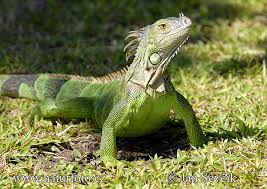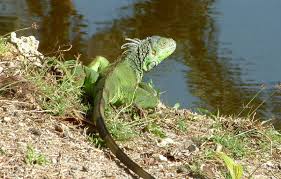
Green iguana
(Iguana iguana)

The green iguana , also known as the American iguana, is a large, arboreal, mostly herbivorous species of lizard of the genus Iguana. It is native to Central, South America, and the Caribbean. Usually, this animal is simply called the iguana. The green iguana ranges over a large geographic area, from southern Brazil and Paraguay as far north as Mexico and the Caribbean Islands. They have been introduced from South America to Puerto Rico and are very common throughout the island, where they are colloquially known as "Gallina de palo" and considered an invasive species; in the United States feral populations also exist in South Florida (including the Florida Keys), Hawaii, the U.S. Virgin Islands and the Rio Grande Valley of Texas.
Scientific classification |
|
| Kingdom: | Animalia |
| Phylum: | Chordata |
| Class: | Sauropsida |
| Order: | Squamata |
| Family: | Iguanidae |
| Genus: | Iguana |
| Specie: | Iguana iguana |
Description

An herbivore, it has adapted significantly with regard to locomotion and osmoregulation as a result of its diet. It grows to 1.5 meters (4.9 ft) in length from head to tail, although a few specimens have grown more than 2 metres (6.6 ft) with bodyweights upward of 20 pounds (9.1 kg).
Commonly found in captivity as a pet due to its calm disposition and bright colors, it can be very demanding to care for properly. Space requirements and the need for special lighting and heat can prove challenging to an amateur hobbyist.
Distribution and habitat

Bolivia and the Caribbean; specifically Grenada, Curaçao, Trinidad and Tobago, St. Lucia, St. Vincent, and Útila. They have been introduced to Grand Cayman, Puerto Rico, Texas, Florida, Hawaii, and the United States Virgin Islands; and colonised the island of Anguilla in 1995 after being washed ashore following a hurricane. Though the species is not native to Martinique, a small wild colony of released or escaped green iguanas endures at historic Fort Saint Louis.
Green iguanas are diurnal, arboreal, and are often found near water. Agile climbers, Iguana iguana can fall up to 50 feet (15 m) and land unhurt (iguanas use their hind leg claws to clasp leaves and branches to break a fall). During cold, wet weather, green iguanas prefer to stay on the ground for greater warmth. When swimming, an iguana remains submerged, letting its four legs hang limply against its side. They propel through the water with powerful tail strokes.
In South and Central America, where the green iguana is native, it is an endangered species in some countries because people have been hunting and eating this "chicken of the trees" for a long time.
Reproduction

Male green iguanas have highly developed femoral pores on the underside of their thighs which secrete a scent (females have femoral pores, but they are smaller in comparison to those of the males). In addition, the dorsal spines that run along a green iguana's back are noticeably longer and thicker in males than they are in females, making the animals somewhat sexually dimorphic.
Male green iguanas tend to display more dominant behaviors, such as head bobbing and tail whipping. They also tend to develop a taller dorsal crest than females, as well as taller dorsal spines (or spikes). Large, round, very pronounced jowls are generally a male characteristic. Jowls are located under the jaw and are protected by the subtympanic plate, which is a large, green, circular-shaped scale.
Green iguanas are oviparous with females laying clutches of 20 to 71 eggs once per year during a synchronized nesting period. The female green iguana gives no parental protection after egg laying, apart from defending the nesting burrow during excavation. In Panama, the green iguana has been observed sharing nest sites with American crocodiles and in Honduras with spectacled caimans.
The hatchlings emerge from the nest after 10-15 weeks of incubation. Once hatched, the young iguanas look similar to the adults in color and shape, resembling adult females more so than males and lacking dorsal spines.
Juveniles stay in familial groups for the first year of their lives. Male green iguanas in these groups often use their own bodies to shield and protect females from predators and it appears to be the only species of reptile which does this.
Behavior

When frightened by a predator, green iguanas will attempt to flee, and if near a body of water, they dive into it and swim away. If cornered by a threat, the green iguana will extend and display the dewlap under its neck, stiffen and puff up its body, hiss, and bob its head at the aggressor. If threat persists the iguana can lash with its tail, bite and use its claws in defense. The wounded are more inclined to fight than uninjured prey.
Green iguanas use "head bobs" and dewlaps in a variety of ways in social interactions, such as greeting another iguana or to court a possible mate. The frequency and number of head bobs have particular meanings to other iguanas.
Green iguanas are hunted by predatory birds and their fear of these is exploited as a ploy to catch them in the wild. The sound of a hawk's whistle or scream makes the iguana freeze and it becomes easier to capture.
Diet
Green Iguanas are primarily herbivores, with captives feeding on leaves such as turnip greens, mustard greens, dandelion greens, flowers, fruit, and growing shoots of upwards of 100 different species of plant. In Panama one of the green iguana's favorite foods is wild plum, Spondias mombin.Although they will consume a wide variety of foods if offered, green iguanas are naturally herbivorous and require a precise ratio of minerals (2 to 1 calcium to phosphorus) in their diet. It is important for captive iguanas to have a variety of leafy greens along with fruits and vegetables such as turnip greens, collards, butternut squash, acorn squash, mango,and parsnip. Juvenile iguanas often eat feces from adults in order to acquire the essential microflora to digest their low-quality and hard-to-process vegetarian-only diet.
There is some debate as to whether captive green iguanas should be fed animal protein. There is evidence of wild iguanas eating grasshoppers and tree snails, usually as a byproduct of eating plant material. Wild adult green iguanas have been observed eating birds' eggs. Zoologists, such as Adam Britton, believe that such a diet containing protein is unhealthy for the animal's digestive system resulting in severe long-term health damage including kidney failure and leading to premature death. On the other side of the argument is that green iguanas at the Miami Seaquarium in Key Biscayne, Florida, have been observed eating dead fish and individuals kept in captivity have been known to eat mice without any ill effects. De Vosjoli writes that captive animals have been known to survive and thrive on eating nothing but whole rodent block, or monkey chow, and one instance of romaine lettuce with vitamin and calcium supplements. However, it is only recommended that captive iguanas not be fed lettuce or meat, and instead receive the vitamins and minerals they need via a purely herbivore diet.
Zoológico de Vallarta A. C.
Leave your comments, your opinion is important to us

